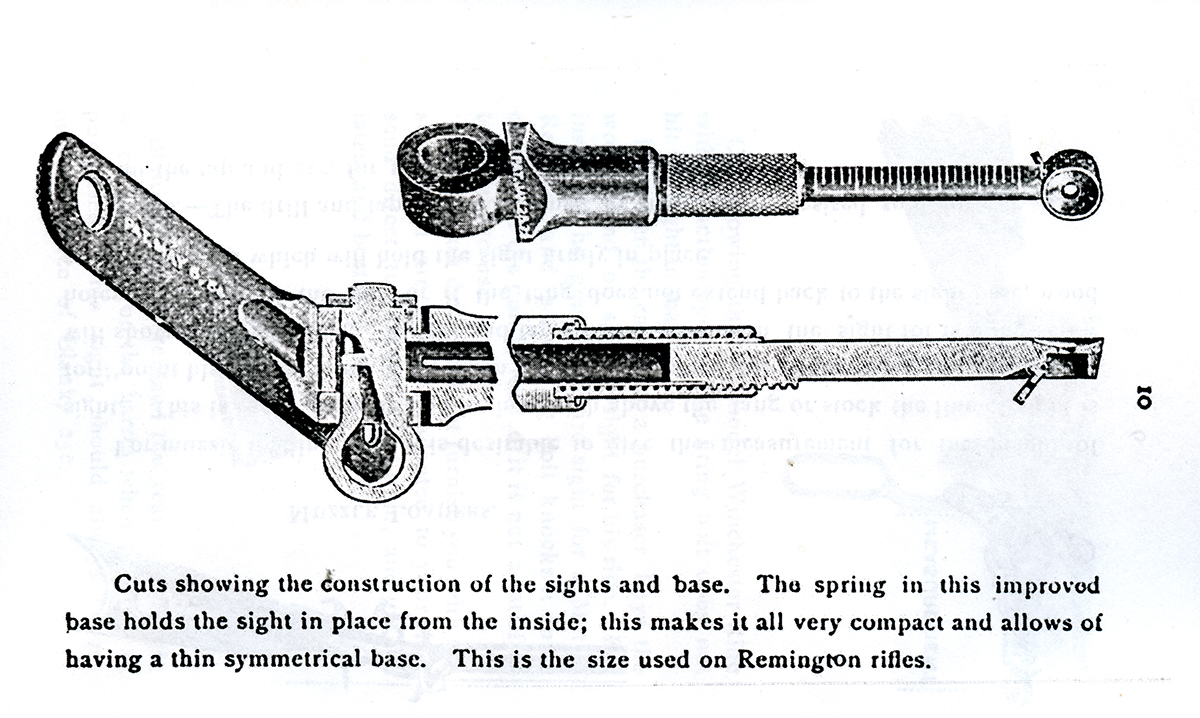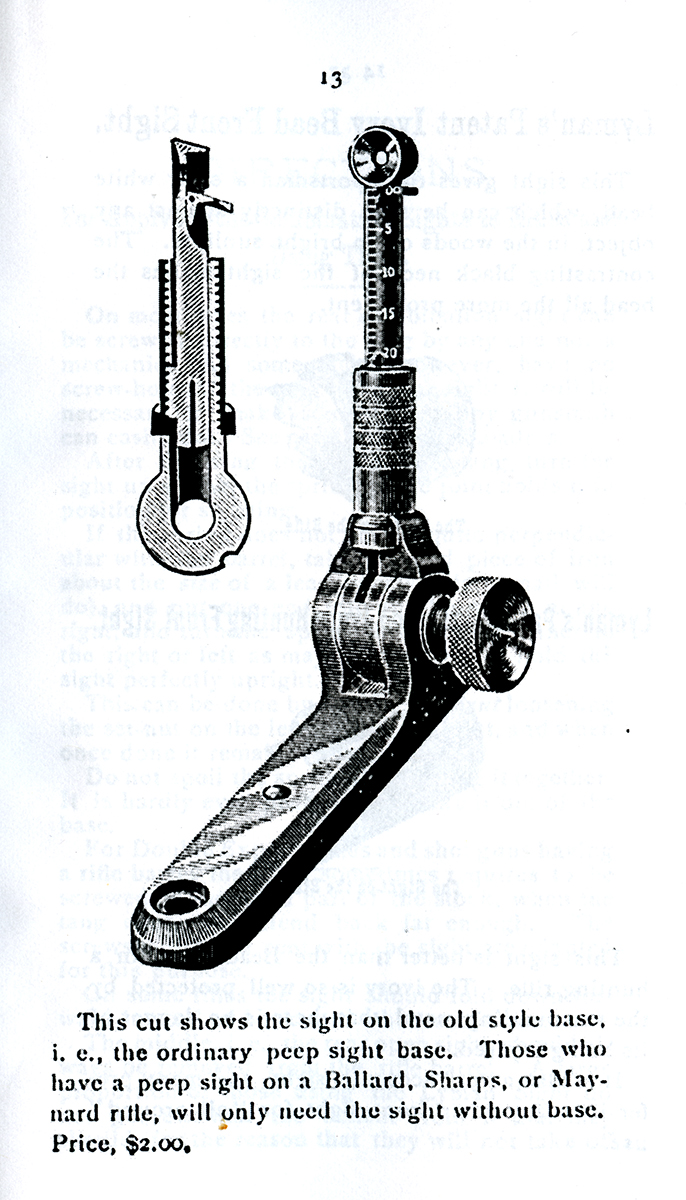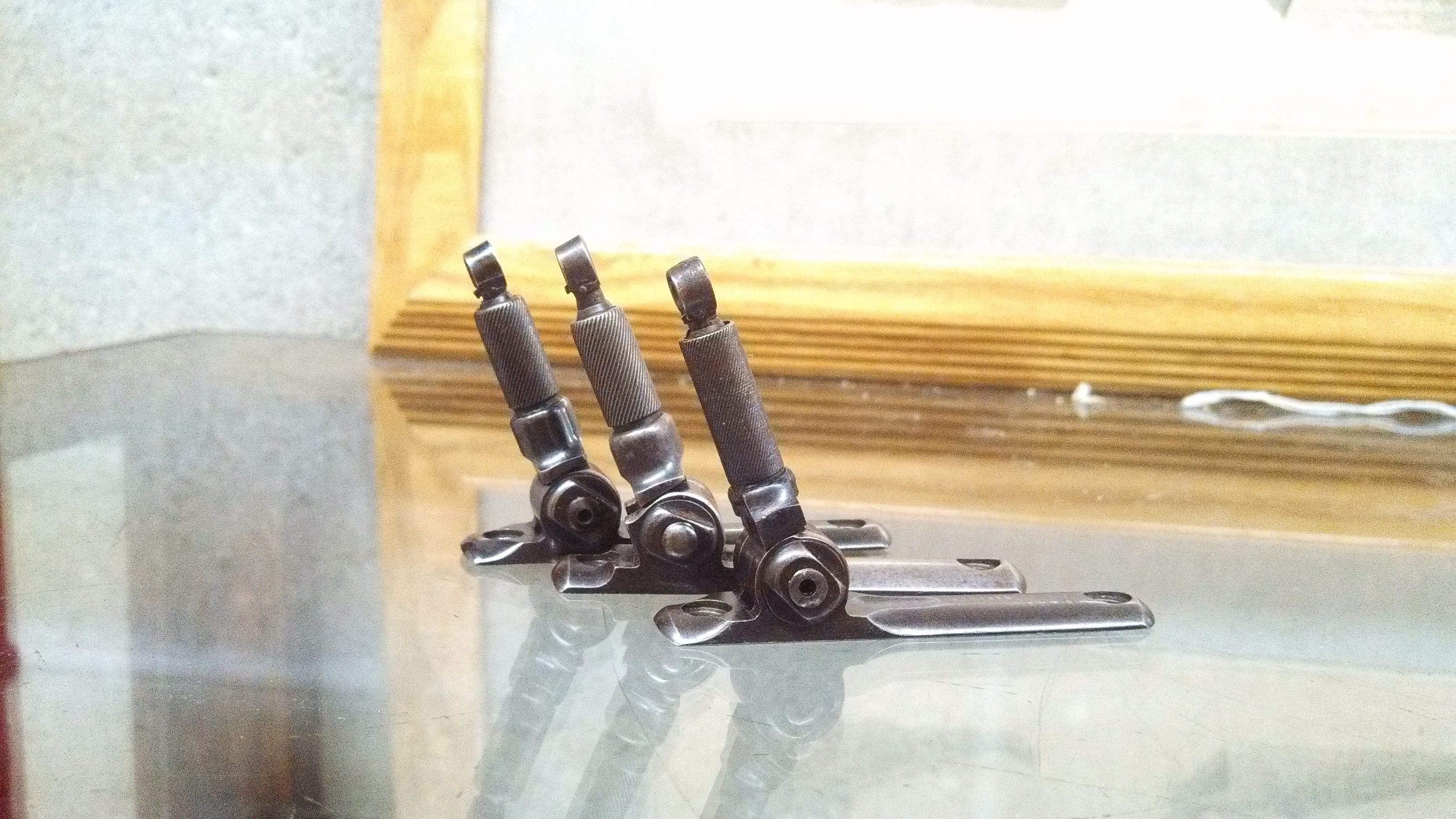July 8, 2016
 Offline
OfflineI recently purchased a Lyman tang sight that I think is a very early one. I have looked it over pretty close with a magnifying light and see only a “D” on the bottom of the base and PAT JAN 29(could be an 8)-79 MAY 6.84 around the stem base right below the knurling. Stampings are very small and hard to read unless one uses a glass and soaps the area well. Nowhere on the sight is a “LYMAN” stamp. The sight has the round, hollowed knob on the right side of the upright pivot, and not the locking lever on the left. It also has a flip down in the aperture that is in tact and works well. From what I read, the first ones did not have the flip down aperture, but that was incorporated before being replaced in 1884 with the second variation. Everything on the sight works well and the action is smooth. Condition wise it is pretty much blue/brown. Even though it was made before the rifle (MOD 1892, 38-40, DOM 1894) I am putting it on, it will match the that rifle condition wise well. According to the literature which I have read, the “D” code was made for the 1894 32-40, 38-55 calibers and the MOD 1892’s. Several questions…what is the purpose of the round, hollow knob on the right side of the pivot base and I don’t understand why Lyman would make the sight (PAT JAN 29 1879-MAY 4 1884) for the listed models BEFORE the models were made?? I’ve only had one coffee the morning and know I’m missing something here. Thanks, Peter
May 2, 2009
 Offline
OfflinePeter,
That is a Lyman 1 tang sight with the flip down aperture. The later Lyman 2 didn’t have the flip down aperture but instead a threaded hole for interchangeable eye cups. The ring on the right side is the spring to make it snap and stay in the upright position, later they came out with the 1A and 2A versions with the locking lever. The patent dates are the dates the first Lyman tang sight were patented and were used on the 73 and 76’s. When they came out with the 94 they just shortened the staff and marked the base “D” or “DA” for the 92 and 94’s and kept the original patent date.
Bob
WACA Life Member--- NRA Life Member---- Cody Firearms member since 1991 Researching the Winchester 1873's

Email: [email protected]
April 15, 2005
 Offline
OfflineEagle said
Still unbelievable to me that they built something that precise way back when. Does someone know when Lyman started making the tang sights? Thanks
Based on the January 1879 patent date, my guess is that Lyman began making tang sights in the year 1878. Brad may have an exact date, as he is our resident WACA member who is researching and studying the history of sights used by Winchester. The earliest production Lyman tang sight I have is the on the bottom rifle in my signature picture (the Fancy Sporting Rifle, 40-90 Ballard). It letters with “Lyman F & R”. Note that the knurling pattern on the early Lyman tang sights is much finer and a different pattern than the more common later sights.
Bert


WACA Historian & Board of Director Member #6571L

December 30, 2011
 Offline
OfflineWilliam Lyman made some tang sights for friends before 1878, then expanded, according to information published by Lyman. He officially founded the company in 1878. I’m sure this information is in Old Gunsights by Nick Stroebel also.
April 15, 2005
 Offline
OfflineIt is a very early second variation. Nick Stroebel did not mention it in his book. He jumped straight from the 1st variation thick-base w/knurled thumb screw to the more common 2nd variation with the coarse knurling on the elevation thimble. The Lyman sight on my rifle also has the patent dates marked on both the top of the base and on the elevation upright… again not mentioned in Stroebel’s book.
Bert
WACA Historian & Board of Director Member #6571L

July 8, 2016
 Offline
OfflineI agree here Bert…there seems to be a lot of things about these early sights that I don’t understand, and have never been able to read much that makes me understand fully what really transpired with the transgression of the sights. I think I get it and then here comes one that is not mentioned. A lot of the pictures in my main go to book show stampings on a sight that are not there at all, and then fail to show some of the sights at all. Wish there was better sources out there with better pictures etc., but realize that it would be a huge undertaking from someone way more talented than I. Peter
December 30, 2011
 Offline
OfflineHi Bert
No, I don’t have any earlier Lyman catalogs unfortunately. I have concentrated on the sights for smokeless rifles for the most part and have not paid close attention to the older sights, and don’t know much about them. I glanced through the Gordon 1873 books also, but didn’t notice an early stem on a later base. However, I did not look really hard at every page. Maybe 1873man knows more about this also. I guess your sight would be in transition or made from the parts at hand if that’s how it came from the factory?
May 2, 2009
 Offline
OfflineWACA Life Member--- NRA Life Member---- Cody Firearms member since 1991 Researching the Winchester 1873's

Email: [email protected]
April 15, 2005
 Offline
OfflineBrad Dunbar said
Hi BertNo, I don’t have any earlier Lyman catalogs unfortunately. I have concentrated on the sights for smokeless rifles for the most part and have not paid close attention to the older sights, and don’t know much about them. I glanced through the Gordon 1873 books also, but didn’t notice an early stem on a later base. However, I did not look really hard at every page. Maybe 1873man knows more about this also. I guess your sight would be in transition or made from the parts at hand if that’s how it came from the factory?
Brad,
The sight is factory original. I do not believe that it is a “transitional” or a “piece parts” sight. I am of the opinion that Lyman specifically made them that way for at least several years before switching to the coarse knurling on the elevation thimble. It appears that Bob has three sights with the same fine cut knurling pattern on thin-bases.
Bert
WACA Historian & Board of Director Member #6571L

December 30, 2011
 Offline
OfflineHey Bert
I meant specifically the sight style in the foreground of Bob’s picture, or on your rifle, that has what looks like an earlier style stem and elevation adjustment on the later, thinner base. I did not mean all of the sights with fine cut knurling on the thin bases. It’s all pretty new to me, like I mentioned earlier. Hopefully I didn’t muddy the waters too much.
May 2, 2009
 Offline
OfflineBert,
I would have to look this weekend when I get home. I just happen to have some sight pictures on my laptop I took a while ago.
I spoke too soon. I just looked and I have another view of the sights. The one in the back has a patent date on the top of the base, the middle one does not look like it has anything and the front one looks like it might.
Bob
WACA Life Member--- NRA Life Member---- Cody Firearms member since 1991 Researching the Winchester 1873's

Email: [email protected]
1 Guest(s)


 Log In
Log In













